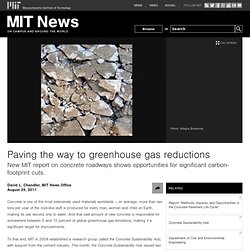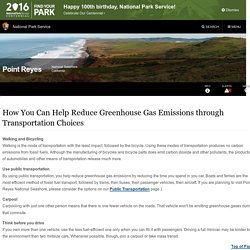

Reduce your carbon footprint. Simple changes in our everyday lives can help slow climate change — including reducing our energy consumption, choosing to travel sustainably, and being conscious of what we purchase.

Switch your home to green energy Did you know that energy use is the biggest contributor to a Canadian home's carbon footprint? More » Food and climate change It's not only what vehicle we drive or how we heat our homes that determines our carbon footprint. The food we eat also has an impact — on our health, and on the environment. More » Four places to cut your carbon Here are some of the easiest and most effective ways, in four key areas, to reduce our carbon footprint and help improve our quality of life. More » Energy efficient lighting Switching to energy efficient lighting represents a great opportunity to reduce your carbon footprint and save money on your electricity bill. Yes, you recycle. But until you start reducing, you're still killing the planet. I talk a lot about reduction.

Reducing the number of toys you have, the quantity of cleaning supplies you buy, even the amount of meat you eat. My constant focus on reduction over recycling, upcycling or disposing of waste responsibly is a deliberate one. Put simply, recycling isn’t enough. Recycling is good, and I’m not here to contradict that. When the options are to either toss a plastic bottle into the recycling bin or into the trash can, you’ll see me shaking my pom-poms for the blue bin. First of all, recycling doesn’t wipe the slate clean. Plastic, my nemesis, is especially problematic in that it can rarely be used for primary reprocessing – the process of breaking down a product and manufacturing it back into that same product. These uses are certainly preferable to its not being reused at all, but it’s important to understand that recycling a plastic bottle doesn’t mean closing the loop. Paving the way to greenhouse gas reductions. Concrete is one of the most extensively used materials worldwide — on average, more than two tons per year of the rock-like stuff is produced for every man, woman and child on Earth, making its use second only to water.

And that vast amount of new concrete is responsible for somewhere between 5 and 10 percent of global greenhouse gas emissions, making it a significant target for improvements. To that end, MIT in 2009 established a research group called the Concrete Sustainability Hub, with support from the cement industry. This month, the Concrete Sustainability Hub issued two major reports — one on concrete pavements, the second on concrete buildings — that examine in detail those products’ life-cycle costs, in both money and greenhouse gas emissions. U.S. Climate Resilience Toolkit. How You Can Help Reduce Greenhouse Gas Emissions as a Consumer - Point Reyes National Seashore (U.S. National Park Service) How You Can Help Reduce Greenhouse Gas Emissions as a Citizen - Point Reyes National Seashore (U.S. National Park Service) Encourage Community ActionYou can work within your community to promote energy efficiency and use of clean energy in a variety of different ways.

Make sure that public buildings are models of energy efficiency and encourage the incorporation of passive-solar techniques in community construction or remodeling projects. Urge your local library, businesses, and church or synagogue to install bike racks. Promote community carpooling plans and the construction of bike lanes. Work to change local zoning ordinances and other regulations that involve energy use. Encourage your local electric utilities to promote energy efficiency and the use of clean, renewable energy sources. Protecting and planting treesProtecting forests and grasslands, and planting new trees contributes to the absorption of carbon dioxide from the air. Letters to the editorWrite to your local newspaper about the significance of the global warming threat and the need for action. How You Can Help Reduce Greenhouse Gas Emissions through Transportation Choices - Point Reyes National Seashore (U.S. National Park Service)
Walking and Bicycling Walking is the mode of transportation with the least impact, followed by the bicycle.

Using these modes of transportation produces no carbon emissions from fossil fuels. Although the manufacturing of bicycles and bicycle parts does emit carbon dioxide and other pollutants, the production of automobiles and other means of transportation release much more. Use public transportation By using public transportation, you help reduce greenhouse gas emissions by reducing the time you spend in you car. How You Can Help Reduce Greenhouse Gas Emissions at Home - Point Reyes National Seashore (U.S. National Park Service) Get a home energy audit Take advantage of the free home energy audits offered by many utilities.

Then put the recommendations into practice. Simple measures, such as installing a programmable thermostat to replace your old dial unit or sealing and insulating heating and cooling ducts, can each reduce a typical family's carbon dioxide emissions by about 5 percent. Replacing single-paned windows with dual-paned windows and installing insulated doors will also greatly reduce heat loss from your home. Use Renewable energy More than half the electricity in the United States comes from polluting coal-fired power plants.
And power plants are the single largest source of heat-trapping gas. In most states, alternatives are available for customers who want to purchase green power (50 to 100 percent renewable energy). Household Carbon Footprint Calculator. Many of our daily activities cause emissions of greenhouse gases.

For example, we produce greenhouse gas emissions from burning gasoline when we drive, burning oil or gas for home heating, or using electricity generated from coal, natural gas, and oil. Greenhouse gas emissions vary among individuals depending on a person's location, habits, and personal choices. For example: The quantity of greenhouse gas emissions from your home electricity use depends on the types of fuel your power plant uses to generate the electricity and the amount you use.
Climate change: Earth's giant game of Tetris - Joss Fong. How to reduce your carbon footprint. Antarctic ice shelf collapse and unstoppable sea level rise 'very likely' without tough climate action, say scientists - Science. Updated Warming of 1.5 to 2 degrees Celsius above current levels could lead to "unstoppable" sea level rise that would last for thousands of years, according to a new model of Antarctic ice sheets.

The new model, published today in Nature, shows that such temperatures would result in 80 to 85 per cent loss of major Antarctic ice shelves, something that is possible by the end of the century under existing IPCC scenarios. How You Can Help Reduce Greenhouse Gas Emissions at Home - Point Reyes National Seashore (U.S. National Park Service) Climate Change. Driving a car, using electricity to light and heat your home, and throwing away garbage all lead to greenhouse gas emissions.

You can reduce emissions through simple actions like changing a light bulb, powering down electronics, using less water, and recycling. This site provides more than 25 easy steps you can take at Home, School, the Office, and On the Road to protect the climate, reduce air pollution, and save money. Top 10 ways you can stop climate change. A simple and smart way to fix climate change. Stop Climate Change. How Can You Stop Climate Change?

Fortunately, there are many ways we can stop climate change. In a nut shell, we need to reduce our carbon footprint which is the total set of greenhouse gas (GHG) emissions we personally cause. Often, when considering someone's carbon footprint, it is usually in terms of the amount of carbon dioxide they directly or indirectly produce. From The Climate Reality Project Reduce Your Carbon Footprint We can reduce our carbon footprint by reducing our consumption of fossil fuels. This can be done by having a car with better fuel economy or simply getting a hybrid, electric or hydrogen fuel cell car.
How to Stop the Arctic Ice and Glaciers from Melting ... Without Spending a Ton Or Imposing Tyranny. The Real Reason the Arctic and Glaciers Are Melting So Fast You know how dark cars get hotter than light cars? And dark clothes absorb heat from the sun more than light clothes? The same thing may explain why the Arctic ice is melting so fast … and give a very hopeful solution. The Economist noted last year: Soot—also known as black carbon—heats up the atmosphere because it absorbs sunlight. The Christian Science Monitor points out: Soot remains in the atmosphere for around seven days – a far shorter time than CO2, which remains in the atmosphere for centuries.
Time wrote in 2009: Unlike CO2, which can hang around in the atmosphere for centuries — CO2 that was emitted by the first coal-powered train is probably still in the air, warming the planet — black carbon has a relatively brief life span. The Institute for Governance & Sustainable Development agrees: The MAIN Cause of Global Warming? One of the world’s leading crusaders against global warming – Dr. The Most Important Short-Term Action. Antarctic Ice Melt Could Get Worse, But Humans Can Slow It Down.
Climate Model Predicts West Antarctic Ice Sheet Could Melt Rapidly. “You could think of all sorts of ways that we might duck this one,” said Richard B. Alley, a leading expert on glacial ice at Pennsylvania State University. “I’m hopeful that will happen. But given what we know, I don’t think we can tell people that we’re confident of that.” Dr. Alley was not an author of the new paper, though it is based in part on his ideas about the stability of glacial ice.